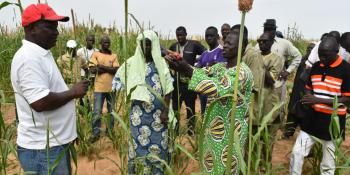Bonn Climate Change Conference 2018 | Improving transparency: Linking MRV and finance for livestock NAMAs to meet the NDCs

Official side event at the Bonn Climate Change Conference 2018.
8th May 2018, 11:30 - 13:00
World Conference Center Bonn, Bonn Room
Countries require sub-national projects to fulfill Nationally Determined Contribution (NDC) commitments, but project accounting, often driven by donors or investors, rarely links to national accounting systems for mitigation and other benefits.
Livestock projects in Latin America may reveal how to connect Nationally Appropriate Mitigation Actions (NAMAs) and national MRV systems.
This side event will explore how measurement, reporting and verification (MRV) of projects in the livestock sector can help countries meet their emission reduction targets and qualify for climate finance.
View the presentation or attend the session virtually through the webcast.
Agenda
Welcome and context | ||
Mitigation in the livestock sector can help countries deliver on their NDCs to the Paris Agreement, but they require high-quality MRV from NAMAs and other sub-national projects. How can this be done? | Lini Wollenberg, CCAFS and the University of Vermont |
|
The challenge | ||
The reporting challenge: Meeting finance and NDC needs | Hayden Montgomery, Global Research Alliance on Agricultural Greenhouse Gases (GRA) |
|
MRV resources | Meryl Richards, CCAFS and the University of Vermont |
|
Experiences from 3 NAMAs in Latin America: System for estimating mitigation impacts, how this meets investors/financiers’ needs and how this contributes (or not) to national MRV and NDC accounting | ||
Brazil | João Lampreia |
|
Guatemala | Ericka Lucero, Scientist, Climate Chante Unity, Ministry of Environment and Natural Resources, Guatemala |
|
Uruguay | Walter Oyhantcabal, Director of the Sustainability and Climate Change Unit, Ministry of Livestock, Agriculture and Fishery, Uruguay |
|
Chat show | ||
Discussion and questions from the audience | ||
Final remarks and the way forward | Martial Bernoux, Food and Agriculture Organization of the United Nations (FAO) | |
Resources for reducing greenhouse gas emissions in the livestock sector
Benefits of advanced inventories (booklet): Using an IPCC Tier 2 approach to estimate emissions can better reflect mitigation due to changes in livestock productivity and efficiency.
Measurement, reporting and verification (MRV) report: MRV of livestock greenhouse gas emissions by developing countries in the UNFCCC: Current practices and opportunities for improvement. Soon available in French and Spanish.
Country reports on low-cost strategies for low emissions development in the livestock sector:
Argentina– focus on beef Bangladesh– focus on dairy
In Colombia, recent research shows that grazing management improvement stands out as a strategy to increase animal productivity, reduce emission intensity and increase soil carbon sequestration.
Lessons from Kenya and Ethiopia, a 2018 report assessing the feasibility of multiple low emissions development interventions for the East African livestock sector.
Country case studies of actions that have reduced emissions intensity but rely on improved MRV to account for changes: Chile Indonesia Sri Lanka
Recent evidence-based research by our partners:
- Genetic mitigation strategies to tackle agricultural GHG emissions: The case for biological nitrification inhibitiontechnology in the journal Plant Science
- Methane and nitrous oxide emissions from cattle excreta on an East African grassland in the Journal of Environmental Quality
- Environmental impacts of dairy farming in Lembang, West Java; Estimation of greenhouse gas emissions and effects of mitigation strategies.
- Climate change mitigation through intensified pasture management: Estimating greenhouse gas emissions on cattle farms in the Brazilian Amazonin the Journal of Cleaner Production
- Rethinking monitoring in smallholder carbon paymentsfor ecosystem services schemes: Devolve monitoring, understand accuracy and identify co-benefits in the journal Ecological Economics
- Symposium review: Uncertainties in enteric methane inventories, measurement techniques, and prediction models in the Journal of Dairy Science
Online resources:
- CCAFS Low emissions researchimproves estimates and MRV of emissions, mitigation, and sequestration in smallholder systems; identifies priorities and options for low emissions development that support food security; and supports widespread implementation of low emissions agriculture practices and policies.
- The Global Research Alliance on Agricultural Greenhouse Gases (GRA), with 50 member countries, is focused on research, development and extension of technologies and practices that will help deliver ways to grow more food (and more climate-resilient food systems) without growing greenhouse gas emissions.
- The GRA’s Livestock Research Group (LRG) is focused on reducing the emissions intensity of livestock production systems and increasing the quantity of carbon stored in soils supporting those systems.
- Reducing greenhouse gas emissions from livestock: A report on global best practice and emerging options in mitigation measures and their potential.
- CCAFS hosts regional centers for climate change and agriculture research; livestock efforts take place in over 12 countries in the global South.
- International Livestock Research Institute (ILRI) and its Mazingira Lab, is a center for climate change and livestock research in East Africa.
- The SAMPLES websiteprovides guidance on measuring emissions from agriculture and local emission factors.
- The Food and Agriculture Organization (FAO) livestock and the environmenttheme produces numerous resources.
Session organizers:
- CGIAR Research Program on Climate Change, Agriculture and Food Security (CCAFS) Low Emissions Development
- New Zealand Government and the Global Research Alliance on Agricultural Greenhouse Gases (GRA)
- Food and Agriculture Organization of the United Nations (FAO)
- International Livestock Research Institute (ILRI)
- University of Vermont Rubenstein School for Environment and Natural Resources and Gund Institute for Environment


